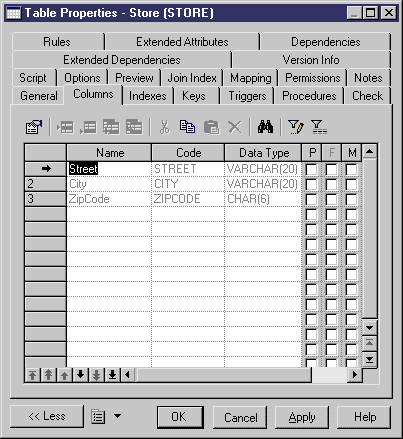

Chapter 3 Building Physical Diagrams
You can double-click any table symbol in a diagram to display its properties:
| Property | Description |
|---|---|
| Name | The name of the item which should be clear and meaningful, and should convey the item's purpose to non-technical users |
| Code | The technical name of the item used for generating code or scripts, which may be abbreviated, and should not generally include spaces |
| Comment | Descriptive label for the table |
| Stereotype | Sub-classification used to extend the semantics of an object without changing its structure; it can be predefined or user-defined |
| Owner | Name of table owner. You choose an owner from a list of users. A table can only have one owner at a time. This is normally the table creator |
| Number | Estimated number of occurrences in the physical database for the table (the number of records). This number is used to estimate database size. The Number box is automatically filled with the actual number of records if you select the check box Retrieve Number of Rows in Tables in the Options page of the Database Reverse Engineering dialog box |
| Generate | Indicates to generate the table in the database |
| Dimensional type | Indicates the multidimensional type of the table, that is Dimension or Fact |
| Type | Indicates the type of the table. It can be relational, object for abstract data types, or XML for storing and retrieving data using an XML format. See section for more details |
A table definition also includes the following properties:
| Property | Description |
|---|---|
| Check | Table constraint that enforces data requirements of check parameters. |
| Script | Begin and end scripts for table creation |
| Preview | SQL code for table |
| Options | Physical options for the table. These are DBMS specific |
| Version Info | Table owner, version number, modification and creation details |
| Notes | Description associated with table |
A table definition also includes the following properties, each with their own respective property sheet that can be accessed independently of the table.
Some DBMS like Oracle or DB2 Common Server support tables based on abstract data types (ADT). A table based on an ADT uses the properties of the ADT and the ADT attributes become table columns.
To link a table to an ADT you have to use the Based On dropdown listbox to select an abstract data type. Not all ADT can be used, only ADT of type Object in Oracle, or Structured in DB2 Common Server appear in the Based On list.

For more information on abstract data types, see section Using abstract data types in a physical diagram.
| Copyright (C) 2005. Sybase Inc. All rights reserved. |

| |